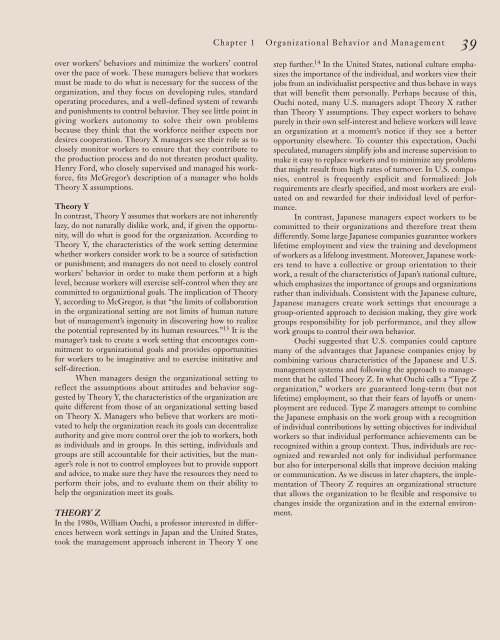chapter - Pearson
chapter - Pearson
chapter - Pearson
You also want an ePaper? Increase the reach of your titles
YUMPU automatically turns print PDFs into web optimized ePapers that Google loves.
Chapter 1<br />
over workers’ behaviors and minimize the workers’ control<br />
over the pace of work. These managers believe that workers<br />
must be made to do what is necessary for the success of the<br />
organization, and they focus on developing rules, standard<br />
operating procedures, and a well-defined system of rewards<br />
and punishments to control behavior. They see little point in<br />
giving workers autonomy to solve their own problems<br />
because they think that the workforce neither expects nor<br />
desires cooperation. Theory X managers see their role as to<br />
closely monitor workers to ensure that they contribute to<br />
the production process and do not threaten product quality.<br />
Henry Ford, who closely supervised and managed his workforce,<br />
fits McGregor’s description of a manager who holds<br />
Theory X assumptions.<br />
Theory Y<br />
In contrast, Theory Y assumes that workers are not inherently<br />
lazy, do not naturally dislike work, and, if given the opportunity,<br />
will do what is good for the organization. According to<br />
Theory Y, the characteristics of the work setting determine<br />
whether workers consider work to be a source of satisfaction<br />
or punishment; and managers do not need to closely control<br />
workers’ behavior in order to make them perform at a high<br />
level, because workers will exercise self-control when they are<br />
committed to organiztional goals. The implication of Theory<br />
Y, according to McGregor, is that “the limits of collaboration<br />
in the organizational setting are not limits of human nature<br />
but of management’s ingenuity in discovering how to realize<br />
the potential represented by its human resources.” 13 It is the<br />
manager’s task to create a work setting that encourages commitment<br />
to organizational goals and provides opportunities<br />
for workers to be imaginative and to exercise inititative and<br />
self-direction.<br />
When managers design the organizational setting to<br />
reflect the assumptions about attitudes and behavior suggested<br />
by Theory Y, the characteristics of the organization are<br />
quite different from those of an organizational setting based<br />
on Theory X. Managers who believe that workers are motivated<br />
to help the organization reach its goals can decentralize<br />
authority and give more control over the job to workers, both<br />
as individuals and in groups. In this setting, individuals and<br />
groups are still accountable for their activities, but the manager’s<br />
role is not to control employees but to provide support<br />
and advice, to make sure they have the resources they need to<br />
perform their jobs, and to evaluate them on their ability to<br />
help the organization meet its goals.<br />
THEORY Z<br />
In the 1980s, William Ouchi, a professor interested in differences<br />
between work settings in Japan and the United States,<br />
took the management approach inherent in Theory Y one<br />
Organizational Behavior and Management<br />
39<br />
step further. 14 In the United States, national culture emphasizes<br />
the importance of the individual, and workers view their<br />
jobs from an individualist perspective and thus behave in ways<br />
that will benefit them personally. Perhaps because of this,<br />
Ouchi noted, many U.S. managers adopt Theory X rather<br />
than Theory Y assumptions. They expect workers to behave<br />
purely in their own self-interest and believe workers will leave<br />
an organization at a moment’s notice if they see a better<br />
opportunity elsewhere. To counter this expectation, Ouchi<br />
speculated, managers simplify jobs and increase supervision to<br />
make it easy to replace workers and to minimize any problems<br />
that might result from high rates of turnover. In U.S. companies,<br />
control is frequently explicit and formalized: Job<br />
requirements are clearly specified, and most workers are evaluated<br />
on and rewarded for their individual level of performance.<br />
In contrast, Japanese managers expect workers to be<br />
committed to their organizations and therefore treat them<br />
differently. Some large Japanese companies guarantee workers<br />
lifetime employment and view the training and development<br />
of workers as a lifelong investment. Moreover, Japanese workers<br />
tend to have a collective or group orientation to their<br />
work, a result of the characteristics of Japan’s national culture,<br />
which emphasizes the importance of groups and organizations<br />
rather than individuals. Consistent with the Japanese culture,<br />
Japanese managers create work settings that encourage a<br />
group-oriented approach to decision making, they give work<br />
groups responsibility for job performance, and they allow<br />
work groups to control their own behavior.<br />
Ouchi suggested that U.S. companies could capture<br />
many of the advantages that Japanese companies enjoy by<br />
combining various characteristics of the Japanese and U.S.<br />
management systems and following the approach to management<br />
that he called Theory Z. In what Ouchi calls a “Type Z<br />
organization,” workers are guaranteed long-term (but not<br />
lifetime) employment, so that their fears of layoffs or unemployment<br />
are reduced. Type Z managers attempt to combine<br />
the Japanese emphasis on the work group with a recognition<br />
of individual contributions by setting objectives for individual<br />
workers so that individual performance achievements can be<br />
recognized within a group context. Thus, individuals are recognized<br />
and rewarded not only for individual performance<br />
but also for interpersonal skills that improve decision making<br />
or communication. As we discuss in later <strong>chapter</strong>s, the implementation<br />
of Theory Z requires an organizational structure<br />
that allows the organization to be flexible and responsive to<br />
changes inside the organization and in the external environment.

















